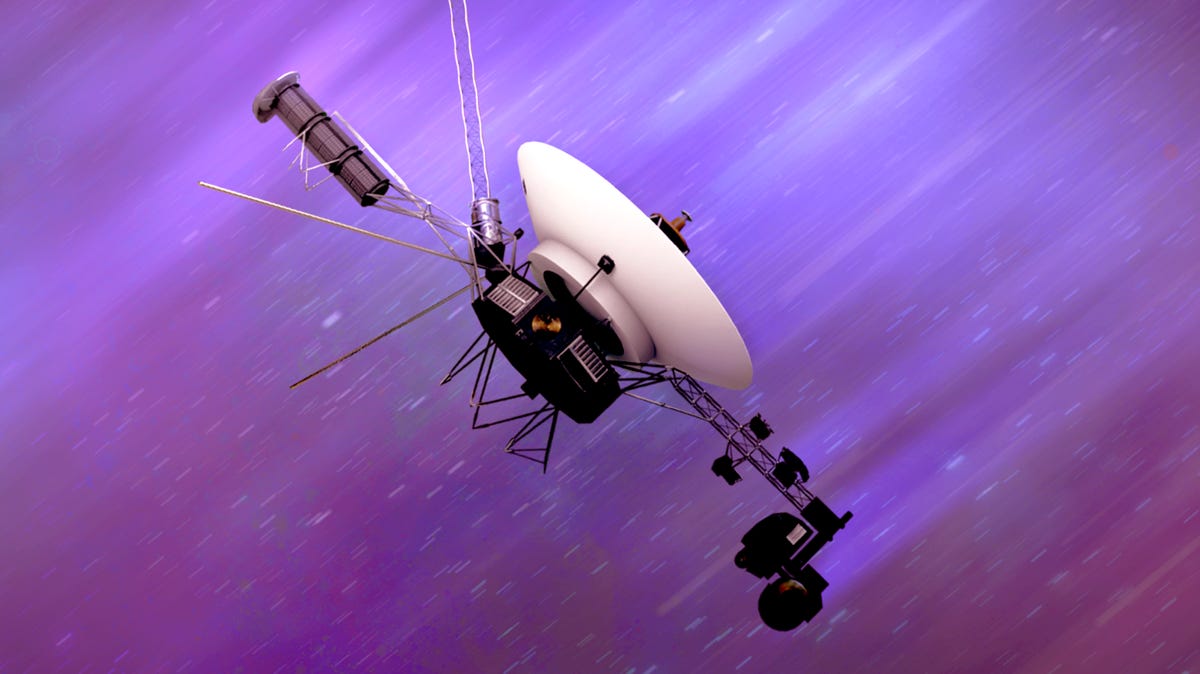It takes a beam of light a single day to travel 16.1 billion miles, a distance known as a light-day. It’ll take Voyager 1, the American spacecraft moving at 10.6 miles per second, more than 49 years to do the same.
Voyager 1, which launched in 1977 and explored Jupiter, Saturn and points beyond, will reach a light-day milestone in November 2026 when it becomes the first craft to travel 16.1 billion miles from Earth.
Distances in space are so vast, astronomers use the speed of light, 186,282 miles per second, to measure them. A light-day is the 16.1 billion miles traveled by light waves and radio signals in 24 hours. A light-year is nearly 6 trillion miles.
By comparison, our solar system is relatively small, averaging about 3.7 billion miles from our sun to Pluto.
Where is Voyager 1 right now?
Can’t see our graphics? Click here to reload the page.
Voyager 1 rocketed into space aboard a Titan IIIE-Centaur from Launch Complex 41 at the Kennedy Space Center in Florida on Sept. 5, 1977.
In flybys, the spacecraft extensively photographed Jupiter in 1979 and Saturn in 1980. It discovered volcanic activity on Io, a moon of Jupiter, and three new moons orbiting Saturn. It also found intricate structures in the ice shapes of Saturn’s rings.
Voyager 1 left our solar system in August 2012 but remains within the sun’s gravitational field. Since entering interstellar space, the craft has been studying plasma waves, cosmic rays and magnetic fields in the heliosphere, the immense bubble of solar wind around the solar system.
Though the spacecraft is the farthest human-made object from Earth, it’s not the only space probe that’s billions of miles away.
Pioneer 10 and Pioneer 11, launched to study Jupiter and Saturn in 1972 and 1973, respectively, are no longer transmitting.
What is a light-year, a light-day, and an AU?Light-year: 5.9 trillion milesLight-day: 16.1 billion milesAU (astronomical unit): 93 million miles
There are about 63,241 AUs in one light-year.
How much longer will Voyager 1 last?
Engineers were able to fix an onboard computer glitch that rendered unreadable the science and engineering data Voyager 1 sent to Earth, The problem started on Nov. 14, 2023.
Engineers from NASA and the Jet Propulsion Laboratory discovered a single computer chip inside the spacecraft’s Flight Data Subsystem – which collects science and engineering information and transmits it – had malfunctioned.
The chip could not be repaired. Instead, engineers moved software code from the chip into a different part of the subsystem’s memory system. That allowed data to be transmitted clearly.
Voyager 1’s distance makes the craft difficult to control. A radio signal takes one day to send and another day for a response to be received. The time lag makes troubleshooting very slow and forces engineers to rely on autonomous systems and redundant hardware.
Voyager 1 is slowly losing power
The spacecraft is powered by three radioisotope thermoelectric generators. The RTGs are mounted on a boom and use plutonium-238 oxide that slowly decays and produces heat. The RTGs convert the heat to electricity.
Voyager 1 doesn’t use much power. At launch, the three RTGs combined produced about 470 watts at 30 volts of electricity, the equivalent of four or five 100-watt incandescent light bulbs.
The craft is down to about 230 watts now, the power of two 100-watt bulbs.
NASA has been shutting down systems on both Voyager craft to conserve power to allow them to continue data transmissions past 2030. Once they lose all electrical power, the Voyagers will keep traveling deeper into space for billions of years.
What is the Golden Record aboard Voyager?
Both Voyager spacecraft carry what’s called the Golden Record, a 12-inch gold-plated copper disk that contains sounds and 115 analog images selected to represent life on Earth.
The record’s aluminum cover contains a cartridge and a needle and has instructive diagrams that show how to play the record and decipher its information.
Carl Sagan of Cornell University chaired a NASA committee that chose the record’s contents.
SOURCE USA TODAY Network reporting and research; Reuters; NASA; Jet Propulsion Laboratory; theskylive.com

